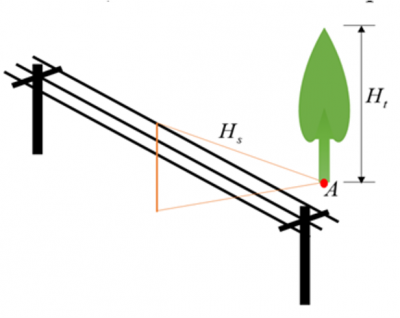With increasing storm intensities projected due to climate change, the resilience of power delivery systems is of increasing importance for both utility companies and customers alike. Strong storms could damage power infrastructures, including the power distribution and transmission systems, leading to widespread power outages for extended periods of time, such as were observed in the northeast following Hurricane Irene, Sandy, and Isaias. Accurate modeling of structural damages under extreme storm events are needed to forecast storm outages and inform decision-makers on cost-effective means of increasing the grid resilience in the coming years. To this end, fragility curves and surfaces of the power infrastructure are developed under various conditions considering factors such as the wind speed and direction, age, pole or member sizes, span, soil conditions, and tree impact forces for improved damage predictions and structural assessments. The main goal is to develop a general and comprehensive framework to evaluate the performance of power infrastructure against extreme weather events and help in simulating and assessing structural probabilistic damage caused by ambient environment load. For this purpose, studies are conducted that could help provide guidance on the understanding of the power system performance and structural failures under natural disasters such as hurricanes and winter storms.
Related Publications:
- Lu, Q., Zhang, W. “An Integrated Damage Modeling and Assessment Framework for Overhead Power Distribution Systems Considering Tree-Failure Risks”, Structure and Infrastructure Engineering, https://doi.org/10.1080/15732479.2022.2053552
- Lu, Q., Zhang, W. (2022) “Integrating Dynamic Bayesian Network and Physics-based Modeling for Risk Analysis of a Time-Dependent Power Distribution System during Hurricanes”, Reliability Engineering & System Safety, Volume 220, April 2022, 108290. https://www.sciencedirect.com/science/article/pii/S0951832021007614
- Lu, Q., Zhang, W., Bagtzoglou, A. (2022) “Physics-Based Reliability Assessment of Community-Based Power Distribution System using Synthetic Hurricanes “, ASCE-ASME Journal of Risk and Uncertainty in Engineering Systems, Part A: Civil Engineering, V8(1), March 2022. https://ascelibrary.org/doi/full/10.1061/AJRUA6.0001205
- Zhang, J., Zhang, W., Lu, Q., Zhu, J., Bagtzoglou, A. (2022) “A Fragility-Weighted Topological Network for Resilient Assessment of Overhead Power Distribution System Subjected to Hurricane Winds”, ASCE-ASME Journal of Risk and Uncertainty in Engineering Systems, Part A: Civil Engineering, V8(2), https://ascelibrary.org/doi/abs/10.1061/AJRUA6.0001232
- Ma, X., Zhang, W., Bagtzoglou, A., Zhu, J. (2021). “Local System Modeling Method for Resilience Assessment of Overhead Power Distribution System under Strong Winds”. ASCE-ASME Journal of Risk and Uncertainty in Engineering Systems, Part A: Civil Engineering, 7 (1) (March 2021). https://doi.org/10.1061/AJRUA6.0001103
- Hughes, W., Zhang, W., Bagtzoglou, A., Wanik, D., Pensado, O, Yuan, H., Zhang, J. (2021). “Damage Modeling Framework for Resilience Hardening Strategy for Overhead Power Distribution Systems”. Reliability Engineering and System Safety, 207, March 2021, 107367. https://doi.org/10.1016/j.ress.2020.107367.
- Yuan, H., Zhang, W., Zhu, J., Bagtzoglou, A. (2018) “Resilience Assessment of Overhead Power Distribution System under Strong Winds for Hardening Prioritization”. ASCE-ASME Journal of Risk and Uncertainty in Engineering Systems, 4(4). https://doi.org/10.1061/AJRUA6.0000988 . Dec. 2018.
- Li, X., Zhang, W., Niu, H.W., Wu, Zheng. “Probabilistic Capacity Assessment of Single Circuit Transmission Tower-Line System Subjected to Strong Winds.” Engineering Structures. 175(11), p 517-530. https://doi.org/10.1016/j.engstruct.2018.08.061. November 2018.
Loads induced by the ambient environment, especially hurricane-induced wind loads, can cause severe damages to power infrastructures such as pole failures and the following system blackout. To ensure the safety of the power infrastructure, damage and performance assessment is necessary. Existing evaluation methods such as data-driven approach or surrogate models could help offer some insights on the damage evaluation and performance appraisal with low computational cost. However, such black-box methods have lower interpretability and are highly dependent on historical data which might be lacking during extreme weather events. Furthermore, the existing power infrastructure performance assessment methods are offering results mainly based on the resource flow data without the consideration of the component failures. Therefore, physics-based power infrastructure structural damage assessment is proposed with the combination of the machine-learning algorithms, and fragility-based power infrastructure performance assessment is put forward to investigate the behavioral change against natural hazards.
Fragility analysis of the poles in the overhead power distribution system (OPDS) as well as the transmission system is performed to describe the structure’s responses to hazard intensity such as wind speed. Previously, empirical mathematic models were utilized to represent the fragility curves for structures in the risk evaluation against strong winds. However, the limit state function with respect to flexural failure mechanism has non-linearity which could cause the calculation highly time-consuming. Therefore, the proposed First Order Reliability Method (FORM) and physics-based analysis with machine-learning algorithms are employed to derive the fragility curve to represent the utility poles’ behavior against winds. Moreover, considering the impact of other factors such as span length, pole age or pole diameter, fragility surfaces of the utility poles could be generated to reflect the impact of multiple characteristics on the pole damage assessment. Figure 1 shows an example of the pole loadings under wind conditions, while Figure 2 shows a sample fragility surface considering span length and wind speed.


Figure 1. Load pattern of the utility poles with wind load and tree load

Figure 2. Fragility surface with respect to wind speed and span length
With the fragility analysis performed, component-level fragility could be derived for power infrastructures. The fragilities could then be used for prediction of structural damages under a forthcoming storm. Figure 3 shows an example map of the projected damage probability to the transmission system. Such maps could be developed to quickly observe which areas might be most prone to outages for crew preparations. Further, such maps could be developed to show the effects of different grid hardening strategies, such as tree trimming, replacement of aging structures, or upgrading the infrastructure to higher classes.

Figure 3. Example map of transmission system predicted failure probability under upcoming storm
System performance assessment could be carried out by integrating the component-level into the system modeling approaches. The power infrastructure’s reliability, indicating the probability of successful power delivery, could be computed by connectivity-based system reliability theory as a metric of the system performance. Hurricane risk models could be integrated to calculate annual failure probabilities. With the thermodynamic analysis calculating the power output from the power generators and the state space modeling computing the reliability of the power generation systems’ reliability, the power delivered to the end-users could also be derived as another metric to represent the system performance by multiplying the generation systems’ output to the reliability of the power distribution system. Sensitivity analysis regarding the decision variables could be put forward to indicate the significance of the variables on the final power delivery and exhibit the impact of the safety metrics. Moreover, graph theory-based metrics such as efficiency could also be utilized to investigate the system vulnerability and resilience regarding the cascading failure under extreme weather events. A dynamic response process analysis framework of power systems with the aim of exploring the response of the system is proposed when it encounters a cascading failure and the repair process after the disaster. Different failure scenarios and restoration strategies could be discussed and compared to help decision-makers in disaster mitigation planning and post-disaster recovering coordination.